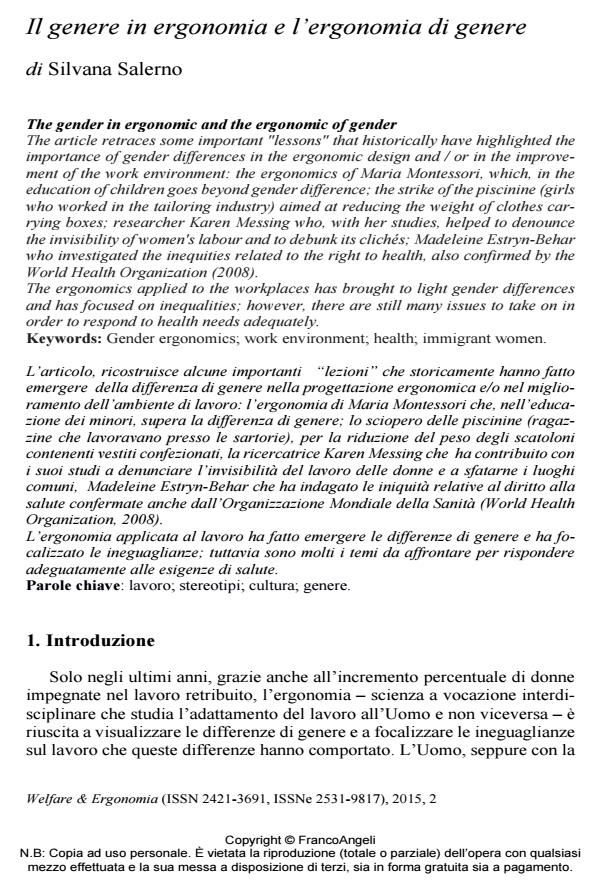The gender in ergonomic and the ergonomic of gender
Journal title WELFARE E ERGONOMIA
Author/s Silvana Salerno
Publishing Year 2017 Issue 2015/2 Language Italian
Pages 11 P. 13-23 File size 249 KB
DOI 10.3280/WE2015-002002
DOI is like a bar code for intellectual property: to have more infomation
click here
Below, you can see the article first page
If you want to buy this article in PDF format, you can do it, following the instructions to buy download credits

FrancoAngeli is member of Publishers International Linking Association, Inc (PILA), a not-for-profit association which run the CrossRef service enabling links to and from online scholarly content.
The article retraces some important "lessons" that historically have highlighted the importance of gender differences in the ergonomic design and / or in the improvement of the work environment: the ergonomics of Maria Montessori, which, in the education of children goes beyond gender difference; the strike of the piscinine (girls who worked in the tailoring industry) aimed at reducing the weight of clothes carrying boxes; researcher Karen Messing who, with her studies, helped to denounce the invisibility of women's labour and to debunk its clichés; Madeleine Estryn-Behar who investigated the inequities related to the right to health, also confirmed by the World Health Organization (2008). The ergonomics applied to the workplaces has brought to light gender differences and has focused on inequalities; however, there are still many issues to take on in order to respond to health needs adequately.
Keywords: Gender ergonomics; work environment; health; immigrant women.
- Berlinguer G. (2011). Storia della salute. Da privilegio a diritto. Firenze: Giunti.
- Chianese G., a cura di (2008). Mondi femminili in cento anni di sindacato. Roma: Ediesse.
- De Troyer M., Vogel L. (2015). Women work and health. Convegno internazionale (Brussels, 4-6 marzo). --Testo disponibile al sito: http://www.etui.org/Events/Women-s-health-and-work.-Sharing-knowledge-and-experiences-to-enhance-womens-working-conditions-and-gender-equality.
- Estryn-Behar M. (2011). Ergonomie hospitalière. Théorie et pratique. Toulouse: Editions Octares.
- Grieco A. (1969). Ergonomia. La Medicina del Lavoro, 60(2): 81-4.
- Hohenadel K., Raj P., Demers P. A., Zahm S. H. and Blair A. (2015). The inclusion of women in studies of occupational cancer: a review of the epidemiologic literature from 1991-2009. American Journal of Industrial Medicine, 58(3): 276-81.
- ilo (International Labour Office) (2015). World Report on Child Labour. --Testo disponibile al sito: http://www.ilo.org/ipec/Informationresources/WCMS_358969/lang--en/index.htm.
- Imprenti F. (2007). Operaie e socialismo. Milano: FrancoAngeli.
- Montessori M. (2000). La scoperta del bambino. Milano: Garzanti Libri.
- Mergler D.. (2012). Neurotoxic exposures and effects: gender and sex matter! Hänninen Lecture. Neurotoxicology, 33(4): 644-51.
- Messing K. (1982). Do men and women have different jobs because of their biological differences?. International Journal of Health Services, 12(1): 43-52.
- Messing K. (1999). One-eyed science: scientists, workplace reproductive hazards, and the right to work. International Journal of Health Services, 29(1): 147-65.
- Messing K. (2015). Pain & Prejudice. What Science Can Learn about Work from the People Who Do It. Toronto: Between the Lines.
- Motti L., a cura di (2006). Donne nella cgil. Una storia lunga un secolo. 100 anni di lotte per la dignità e i diritti e la libertà femminile. Roma: Ediesse.
- Niedhammer I., Saurel-Cubizolles M. J., Piciotti M. and Bonenfant S. (2000). How is sex considered in recent epidemiological publications on occupational risks?. Occupational and Enrivonmental Medicine, 57(8): 521-7.
- Proust M. (2012). La parte di Guermantes (trad. it. G. Raboni). Milano: Mondadori, pp. 14-5.
- Salerno S. (2007). L’ergonomia di Maria Montessori. Rivista di Ergonomia, 7/8: 4-9.
- Salerno S. (2014). Riconoscimento delle malattie muscolo-scheletriche da lavoro in Italia: esiste una disuguaglianza per il genere femminile?. Giornale italiano di Medicina del Lavoro ed Ergonomia, 36: 4, Supplemento.
- Salerno S., Soldati O. e Giliberti C. (2015). Infortuni in itinere: analisi dei dati statistici inail delle morti e dei danni permanenti per una prevenzione di genere. La Medicina del Lavoro, 106: 107, Supplemento 2.
- who (World Health Organization, Commission on social determinants of health) (2008). Final Report on Closing a gap in a generation. Health equity through action on the social determinants of health.
- Introduzione Silvana Salerno, Valeria Quaglia, in WELFARE E ERGONOMIA 1/2022 pp.31
DOI: 10.3280/WE2022-001004
Silvana Salerno, Il genere in ergonomia e l’ergonomia di genere in "WELFARE E ERGONOMIA" 2/2015, pp 13-23, DOI: 10.3280/WE2015-002002